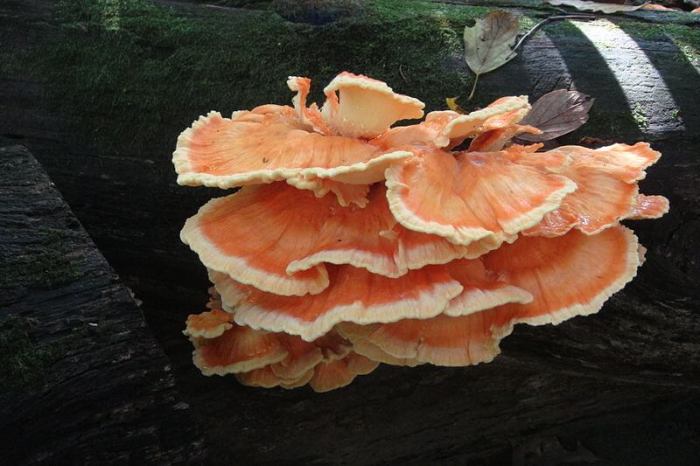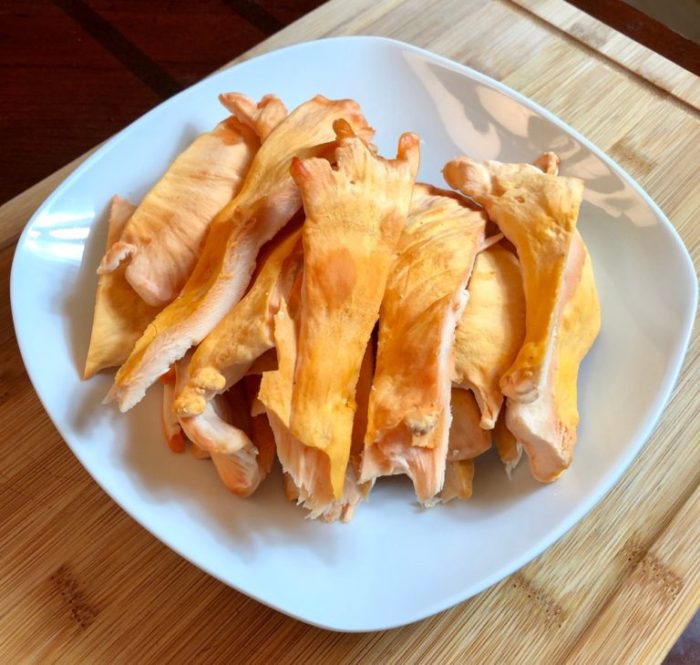
Embark on a culinary expedition with our comprehensive chicken of the woods recipe guide. Dive into the world of this delectable mushroom, exploring its versatile flavors, cooking techniques, and nutritional benefits. Whether you’re a seasoned forager or a curious home cook, this guide will equip you with everything you need to savor the wonders of chicken of the woods.
From sautéing to grilling, we’ll uncover the secrets to unlocking the mushroom’s unique texture and taste. Discover the perfect pairings and side dishes to elevate your culinary creations. Plus, delve into the nutritional value of chicken of the woods and its potential health benefits.
Recipe Variations: Chicken Of The Woods Recipe
Chicken of the woods is a versatile mushroom that can be used in a variety of recipes. Here are a few popular variations:
Vegetarian or vegan alternatives:
- Oyster mushroomshave a similar texture to chicken of the woods and can be used in many of the same recipes.
- King oyster mushroomsare another good option for a meaty texture.
- Shiitake mushroomshave a more intense flavor and can be used in stir-fries, soups, and stews.
Recipes that cater to specific dietary restrictions:
- Gluten-free:Use gluten-free bread crumbs or flour in your recipes.
- Low-carb:Avoid breading or frying the mushrooms, and instead grill, roast, or sauté them.
Cooking Methods

Chicken of the woods is a versatile mushroom that can be cooked in various ways, each with its unique advantages and disadvantages. Let’s explore the different cooking methods to help you achieve the optimal texture and flavor for your dish.
The most common cooking methods for chicken of the woods include sautéing, roasting, and grilling.
Sautéing
- Sautéing involves cooking the mushroom in a pan with a small amount of oil over medium heat. This method is quick and easy, and it allows you to control the browning and texture of the mushroom.
- Pros: Sautéing allows for quick cooking, precise control over browning, and versatility in adding flavors.
- Cons: Sautéing may not be suitable for large quantities of mushrooms, and it requires constant attention to prevent burning.
Roasting
- Roasting involves baking the mushroom in an oven at a high temperature. This method produces a caramelized exterior and a tender interior.
- Pros: Roasting provides an even cook, develops a rich flavor, and is suitable for large quantities of mushrooms.
- Cons: Roasting can take longer than other methods, and it may not be as versatile in terms of adding flavors.
Grilling
- Grilling involves cooking the mushroom over direct heat on a grill. This method imparts a smoky flavor and a slightly charred exterior.
- Pros: Grilling provides a unique smoky flavor, creates a crispy texture, and is suitable for outdoor cooking.
- Cons: Grilling may not be suitable for all types of mushrooms, and it requires careful monitoring to prevent burning.
Pairing and Flavor Profiles

Chicken of the woods has a meaty, savory flavor that pairs well with a variety of ingredients. It can be used in place of chicken in many recipes, or it can be enjoyed on its own as a vegetarian or vegan main course.Some
of the best ingredients to pair with chicken of the woods include:* Vegetables: Chicken of the woods goes well with a variety of vegetables, including onions, garlic, bell peppers, mushrooms, and zucchini.
Herbs and spices
Chicken of the woods can be seasoned with a variety of herbs and spices, including thyme, rosemary, oregano, basil, and paprika.
Sauces
Chicken of the woods can be served with a variety of sauces, including tomato sauce, cream sauce, or barbecue sauce.
Complementary Side Dishes
Chicken of the woods can be served with a variety of side dishes, including:* Rice
- Pasta
- Potatoes
- Bread
- Salad
Complementary Sauces
Chicken of the woods can be served with a variety of sauces, including:* Tomato sauce
- Cream sauce
- Barbecue sauce
- Gravy
Nutritional Benefits

Chicken of the woods is a nutritional powerhouse, boasting an impressive array of vitamins, minerals, and antioxidants. It’s a rich source of dietary fiber, which aids in digestion and promotes a feeling of fullness. Additionally, it contains essential vitamins like vitamin D, which is vital for bone health, and B vitamins, crucial for energy metabolism.
Comparison to Other Edible Mushrooms, Chicken of the woods recipe
Compared to other edible mushrooms, chicken of the woods stands out for its high protein content. It packs approximately 10-15% protein by weight, making it a valuable meat alternative for vegetarians and vegans. Moreover, it has a lower fat content than many other mushrooms, making it a healthier choice.
Potential Health Benefits
Consuming chicken of the woods may offer several potential health benefits. Its high antioxidant content helps protect cells from damage caused by free radicals, reducing the risk of chronic diseases like cancer and heart disease. Additionally, the mushroom contains beta-glucans, which have been shown to boost the immune system and enhance overall well-being.
Foraging and Identification

Chicken of the woods is a relatively easy mushroom to find, as it grows on dead or dying hardwood trees. It is typically found in the spring and fall, and can be found in both deciduous and coniferous forests.When foraging for chicken of the woods, it is important to be able to identify it accurately.
The mushroom has a bright orange or yellow cap that is typically lobed or shelf-like. The flesh is white and firm, and the mushroom has a mild, slightly fruity flavor.It is important to practice responsible foraging practices when harvesting chicken of the woods.
Only harvest mushrooms that you are certain are edible, and never take more than you need.
Tips for Identifying Chicken of the Woods
* The cap of the mushroom is typically bright orange or yellow, and is often lobed or shelf-like.
- The flesh of the mushroom is white and firm.
- The mushroom has a mild, slightly fruity flavor.
- Chicken of the woods typically grows on dead or dying hardwood trees.
- The mushroom is typically found in the spring and fall.
Outcome Summary

As you embark on your chicken of the woods culinary journey, remember to practice responsible foraging practices. By understanding the importance of sustainable harvesting, we can ensure the preservation of this extraordinary mushroom for generations to come.
So, grab your baskets, fire up your stoves, and let’s venture into the delicious world of chicken of the woods. Prepare to tantalize your taste buds and expand your culinary horizons with this extraordinary gift from the forest.
Essential FAQs
What are some vegetarian or vegan alternatives to chicken of the woods?
Consider oyster mushrooms or king oyster mushrooms as meaty substitutes in your recipes.
How do I identify chicken of the woods accurately when foraging?
Look for its bright orange to yellow coloration, unique shelf-like shape, and growth on hardwood trees.
What are the potential health benefits of consuming chicken of the woods?
This mushroom is rich in antioxidants, beta-glucans, and other compounds linked to immune support and reduced inflammation.





